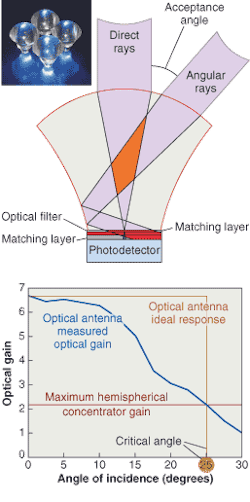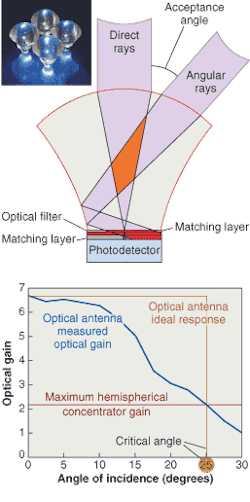Compact concentrator boosts light to detector
Although the addition of focusing optics can increase the amount of light collected by a photodetector, it introduces a tradeoff between optical gain (the ratio between the input aperture area and the detector's surface area) and acceptance angle. The largest acceptance angle for a given optical gain is achieved by nonimaging optics; the compound parabolic concentrator (CPC), invented by Roland Winston of the University of Chicago, is one example of this type of design. Although intended primarily for use in solar collectors, the CPC has been used for photodetectors as well.
A further increase in optical gain can be obtained when the photodetector and concentrating mirrors are immersed in a clear dielectric; such an arrangement increases concentration by a factor of the square of the material's refractive index for an optimal two-dimensional concentrator. But the large height and volume of a CPC means that a dielectric-filled CPC would be heavy and unwieldy for some detector applications. Based on research done at the University of Warwick (Coventry, England), engineers at Optical Antenna Solutions (OAS; also of Coventry) have developed a clear-plastic-filled photodetector concentrator—which they call an optical antenna—that is small and lightweight and yet achieves an optical gain of up to 6.6.
In the OAS device, the top dielectric surface has a convex shape (see schematic and inset photo). The geometry of the top surface, the refractive index of the plastic, and the required concentration and field of view then determine the nature of the side surface (concave or convex), according to Roger Green, a professor at the University of Warwick and one of the researchers. The optical gain of the device hovers near its maximum of 6.6 over a ±12° range, then drops smoothly to a gain of 2 at 25° (see graph).
A high optical gain allows design engineers to develop for smaller active detector areas, thus reducing capacitive properties, says Green. The gain of the optical antenna is compared to that of a hemispherical concentrator conventionally used with photodetectors to increase light collection.
The optical antenna is intended for use in mobile telephones, personal digital assistants, IrDA transceivers, and other infrared wireless devices, and may find use in the visible spectrum as well, notes Green.

